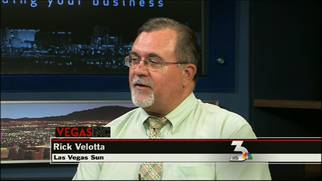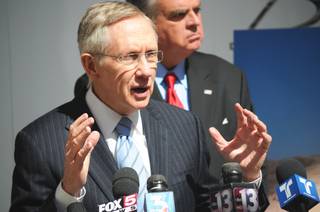
Richard N. Velotta
VEGAS INC Archives
- DesertXpress project takes another step forward (11-18-11)
- Panelists: Opponents of high-speed rail making familiar arguments (11-04-11)
- Proposed DesertXpress high-speed rail line chugging along (10-26-11)
- Neighborhood association slams DesertXpress rail plan (10-13-11)
- With lack of funding, will DesertXpress ever lay its tracks? (7-25-11)
- DesertXpress hopes for federal loan, aims for 2012 start on work (10-10-2011)
VEGAS INC: Rick Velotta discusses DesertXpress

Viewing video requires the latest version of Adobe's Flash Player
VEGAS INC reporter Rick Velotta discusses plans and funding for DesertXpress, the high-speed rail that will connect Southern California and Southern Nevada
As I covered a panel discussion at the recent Western High-Speed Rail Alliance conference at which a representative of DesertXpress Enterprises made a presentation about high-speed rail in the West, I found myself wondering whether a room full of rail experts would question some of the flaws of a system connecting Las Vegas and Victorville, Calif.
They didn’t.
That led me to the conclusion that either most of the experts in the room believe the DesertXpress plan would be successful despite its flaws or that they didn’t think there were any flaws.
Or, maybe they just didn’t care to say anything negative because most in the industry really want to see it succeed.
Like it or not, DesertXpress is further along than any high-speed rail system in the country and for those who dream of someday developing a network of fast trains crisscrossing the United States, it represents the best hope for having something that passengers can see, touch and ride that resembles what Europe and Asia have had for years.
Unfortunately, if the system fails it could forever doom high-speed ground transportation, a concept I’m convinced would benefit our country if done right.
The biggest problem the rail industry has today is that it’s overpopulated with decision-makers rooted in the past. They’re happy with status quo, satisfied with a rail system that will run at 150 mph, which, by today’s standards, is hardly high-speed.
They’re fine with a system in California that uses commuter rail and freight tracks instead of a dedicated line.
DesertXpress is OK that Victorville is a southern terminus and hopeful that somehow, someday a rail line that isn’t even in the planning stages will connect it to the California system at Palmdale.
Whatever happened to vision and entrepreneurship? It’s apparently not living in the world of high-speed rail. There are too many lawmakers and administrators getting advice from existing train manufacturers, unwilling to consider the potential for something really groundbreaking to put the United States at the forefront of high-speed transportation instead of trailing the likes of France and Italy.
One of my colleagues across town, Adrienne Packer, made the case that by the time DesertXpress and California’s high-speed system are completed, probably by 2034, their technology will have been lapped by innovations like driverless cars. With truly high-speed systems and maglevs already operating commercially in other parts of the world, it’s safe to say the system DesertXpress envisions already is obsolete.
Related to this discussion, a recent flurry of updates about DesertXpress have unleashed a new collection of misinformation that needs to be clarified.
Critics have unfairly bashed DesertXpress as a government boondoggle. The company building this train is private and no public money has been spent. It’s true that the company has applied for a $4.9 billion federal loan and that the application is in the process of being evaluated by the Federal Railroad Administration.
To me, that doesn’t constitute the spending of taxpayer dollars. If the loan is approved and it fails, maybe then the critics can complain about the use of public money. I’m still not convinced the company would get such a sizable loan, but we all know that there are extraordinary politics involved in this deal so it wouldn’t be surprising if it’s approved.
One other point of clarification: We need to get over Victorville being the southern terminus for the project. It should be abundantly clear to all that this train isn’t something intended for use by Southern Nevadans. The only benefit we may get is the additional tourists it could bring to our city.
If the developers cared at all about local residents, they would have found a way to engineer the train all the way to Los Angeles or Orange County without having to rely on the very iffy Victorville-to-Palmdale connection to miraculously occur.
But they don’t.
It’s all about trying to make a buck bringing Southern Californians to Las Vegas, which I’m still unconvinced will ever happen given the difficulty of prying Californians from their cars.
But who knows, maybe there are more people out there than we know that won’t mind parking their cars and riding a train to Las Vegas where they’ll have to rely on taxis, buses and the monorail to get around.
For the sake of the future of high-speed rail in the West, let’s hope so.

